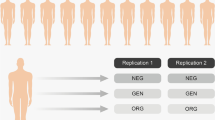Abstract
Purpose
The existence of a sex-by-formulation interaction in bioequivalence studies implies that the bioequivalence results (i.e., the test/reference ratio of the pharmacokinetic parameters) obtained in one sex are not similar to those obtained in the other sex. Therefore, results obtained in studies including only males may not be representative of the results obtained in females and vice versa. The best evidence of the existence of a sex-by-formulation interaction has been obtained from a study conducted with transdermal patches. This observation might be caused by the different characteristics of the skin of males and females. The purpose of this work is to investigate the existence of a sex-by-formulation interaction in all bioequivalence studies of transdermal patches submitted to the Spanish Agency for Medicines between 2010 and 2016.
Methods
Only five different products (Buprenorphine-1, Fentantyl-1, Fentanyl-2, Rivastigmine-1 and Rivastigmine-2) that were submitted for registration included nine bioequivalence studies conducted in males and females. As single dose and multiple dose studies are required for registration of transdermal patches in the European Union, more than one study may be available to confirm the existence of a sex-by-formulation interaction.
Results
A sex-by-formulation interaction is suggested in six out of 27 datasets (22%), corresponding to two products, and it is statistically significant in three of them (11%).
Conclusions
The sex-by-formulation interaction detected in some pharmacokinetic parameters of some studies is excluded when the study is repeated, which shows that these results are not reproducible. There is no evidence to require bioequivalence demonstration for transdermal patches in males and females separately.








Similar content being viewed by others
References
Koren G, Nordeng H, MacLeod S (2013b) Gender differences in drug bioequivalence. Time to rethink practices. Clin Pharmacol Ther 93(3):260–262. https://doi.org/10.1038/clpt.2012.233
European Medicines Agency. Guideline on the investigation of bioequivalence. London, 2′ January 2010. CPMP/EWP/QWP/1401/98 Rev. 1/ Corr ** http://www.ema.europa.eu/docs/en_GB/document_library/Scientific_guideline/2010/01/WC500070039.pdf. (Accessed 29.04.2017).
U.S. Department of Health and Human Services, Food and Drug Administration. Center for Drug Evaluation and Research (CDER). Guidance for Industry. Bioavailability and Bioequivalence. Studies for Orally Adminsitered Drug Products - General Considerations. March 2003, revision 1. http://www.fda.gov/ohrms/dockets/ac/03/briefing/3995B1_07_GFI-BioAvail-BioEquiv.pdf. (Accessed 29.04.2017)
González-Rojano E, Abad-Santos F, Ochoa D, Román M, Marcotegui J, Álvarez C, Gordon J, García-Arieta A (2018) Evaluation of sex-by-formulation interaction in bioequivalence studies of efavirenz tablets. Br J Clin Pharmacol 84(8):1729–1737. https://doi.org/10.1111/bcp.13601
Chen ML, Lee SC, Ng MJ, Schuirmann DJ, Lesko LJ, Williams RL (2000) Pharmacokinetic analysis of bioequivalence trials: implications for sex-related issues in clinical pharmacology and biopharmaceutics. Clin Pharmacol Ther 68(5):510–521. https://doi.org/10.1067/mcp.2000.111184.
Giacomoni PU, Mammone T, Teri M (2009) Gender-linked differences in human skin. J Dermatol Sci 55(3):144–149. https://doi.org/10.1016/j.jdermsci.2009.06.001
Jacobi U, Gautier J, Sterry W, Lademann J (2005) Gender-related differences in the physiology of the stratum corneum. Dermatology 211(4):312–317. https://doi.org/10.1159/000088499
Luebberding S, Krueger N, Kerscher M (2013) Skin physiology in men and women: in vivo evaluation of 300 people including TEWL, SC hydration, sebum content and skin surface pH. Int J Cosmet Sci 35(5):477–483. https://doi.org/10.1111/ics.12068
García-Arieta A, Morales-Alcelay S, Herranz M, de la Torre-Alvarado JM, Blázquez-Pérez A, Suárez-Gea ML, Alvarez C (2012) Investigation on the need of multiple dose bioequivalence studies for prolonged-release generic products. Int J Pharm 423(2):321–325. https://doi.org/10.1016/j.ijpharm.2011.11.022.
Alkilani AZ, McCrudden MTC, Donnelly RF (2015) Transdermal drug delivery: innovative pharmaceutical developments based on disruption of the barrier properties of the stratum corneum. Pharmaceutics 7:438–470. https://doi.org/10.3390/pharmaceutics7040438
Ibarra M, Magallanes L, Lorier M, Vázquez M, Fagiolino P (2016) Sex-by-formulation interaction assessed through a bioequivalence study of efavirenz tablets. Eur J Pharm Sci 85:106–111. https://doi.org/10.1016/j.ejps.2016.02.001
European Medicines Agency. Guideline on the investigation of subgroups in confirmatory clinical trials (draft), 23 January 2014. EMA/CHMP/539146/2013. http://www.ema.europa.eu/docs/en_GB/document_library/Scientific_guideline/2014/02/WC500160523.p. Accessed 29 April 2017
Acknowledgements
The authors are grateful to Mr. Jesús Garrido for his assistance in the statistical analysis.
Author information
Authors and Affiliations
Contributions
A.G.-A., J.G. and E.G.-R. contributed to the conception of the work and the interpretation of the results. A.G.-A. and S.M. contributed in the acquisition of the data of the bioequivalence studies of transdermal patches submitted to the Spanish Agency for Medicines and Health Care Products. E.G.-R., J.M., F.A-S. and C.Á. conducted the analysis of the data.
Corresponding author
Ethics declarations
Conflict of interest
The authors declare that they have no conflict of interest.
Additional information
Publisher’s note
Springer Nature remains neutral with regard to jurisdictional claims in published maps and institutional affiliations.
Electronic supplementary material
ESM 1
(DOCX 15 kb)
Rights and permissions
About this article
Cite this article
González-Rojano, E., Marcotegui, J., Morales-Alcelay, S. et al. Sex-by-formulation interaction in bioequivalence trials with transdermal patches. Eur J Clin Pharmacol 75, 801–808 (2019). https://doi.org/10.1007/s00228-019-02632-1
Received:
Accepted:
Published:
Issue Date:
DOI: https://doi.org/10.1007/s00228-019-02632-1




